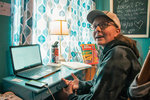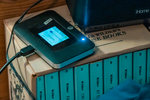


Amanda Linwood, a seventh grader at Chehalis Middle School, was just about to complete her first week of the 2020-2021 school year on Sept. 3 when her internet suddenly went out.
While trying to reconnect, her first-period class ended and her second-period class started. Linwood’s mother, Teresa Linwood, received an email from the school saying her daughter was absent from class. So Teresa was forced to to clear up the absence while heading into the four-day Labor Day Weekend.
The Linwoods live two miles from Centralia Safeway and have been fighting for years to get stable, reliable high-speed internet at their home on Goodrich Road.
Spotty internet service is just one of many problems facing students and parents in Lewis County as they transition to distance learning this fall. Mossyrock and Boistfort school districts are the only two in the county who started the year using a hybrid in-person/online class model, while students and parents from the others are left navigating this new environment in a county with large swaths of unreliable internet.
A survey by the Lewis County PUD saw 23 percent of its 3,673 respondents say they have internet speeds of less than 25 megabits per second (Mbps). According to the Federal Communications Commission (FCC), an area is “underserved” if it has less than 25 mbps download speed.
The survey also found that 53.8 percent of respondents were less than satisfied with their current service’s speed, while 36.4 were less than satisfied with reliability and 61.6 were less than satisfied with its price value.
It’s even more frustrating for a county where the bulk of its population lives along the Interstate 5 corridor. The utility pole on the far side of their next-door neighbor’s house is where internet providers stop their service. An imaginary line. Linwood can see the pole from her living room.
“Their cable is right there,” Linwood said. “But because we don’t have the demand at the end of our road for high-speed internet, they won’t continue it out.”
There are two other families out there who are struggling, trying to get distance learning going, Linwood said. But living in rural farmland on the outskirts of Ford’s Prairie is holding them hostage, Linwood said, because they don’t have a bulk of houses out there to coerce an internet provider to extend its service.
Dish Network said it can put up a satellite dish, but it’s only for TV, not internet. They’ve been recommended to use the hotspot through their cell phones, but that doesn’t work well enough to support a Zoom meeting.
So they’ve been forced to use a HomeBox through U.S. Cellular for $130 a month, which is basically a portable hotspot, but that doesn’t work consistently on a daily basis. Even when it does, only one person at a time can use the internet, and even streaming a movie has become nearly impossible.
“It has about the same reliability as dial-up from 10 years ago,” Linwood said.
The Linwoods did receive a pocket-sized hotspot from the school district on Sept. 10. It is supposed to support up to five devices, but only has two bars of service at their house and can only hold a Zoom call, at the most. If Amanda is the only one using it, she can complete her classes and schoolwork, but if another family member tries to use the internet at the same time, it will drop service.
“There are just so many people out there that need help, and I know the school district is trying to weed its way through this mess,” Linwood said. “Teachers are doing what they can.”
It’s been difficult for Teresa, too, who works for a real estate agency in Centralia. She has the option to work in the office but doesn’t want to leave Amanda home alone during the school day. Amanda’s first two periods two days a week are band, where she plays the saxophone and ukulele, so Teresa can’t bring Amanda to work with her. It’s forced Teresa to work anywhere from 3 p.m. to midnight after Amanda is finished with schoolwork and the internet is freed up.
“I know there are more people out there in the county who are struggling worse off than I am, but it’s frustrating for every student, even if they have high-speed internet,” Linwood said. “I think everybody should be able to have internet that’s reliable enough for these kids to go online distance learning.”
The King Family
On a Wednesday afternoon, Nikki King and her three children are at a park in Toledo. Her first grader and third grader are doing P.E. after having just completed P.E. class online where they watched jump-roping videos.
Her two school-aged children are both in the Chehalis School District, but the only problem is, they don’t have internet service at their home. So when King found out that the district was moving to an online distance-learning model, it was a scramble to figure out how to make it work.
“I was disappointed and frustrated,” King said. “I was not sure how we were going to do it.”
Luckily, King has a sister who lives in Winlock. So she packs lunches like any normal school day and then hauls her kids to her sister’s house, staying there from 8 a.m. to 3 p.m. so her children can complete their schoolwork.
“Very lucky and very thankful that they offered their house for us to use the internet,” King said. “They’re being very graceful. It’s not too bad right now.”
The Kings’ home is about two miles from the school but also in a dark zone, meaning internet access is few and far between. Their only options are either HughesNet satellite or CenturyLink.
HughesNet has unstable service in their area and it wants the Kings to sign up for a two-year contract, which they are unwilling to do for unreliable internet. They also don’t want to pay a large amount of money upfront to not be in a contract, King said.
Their neighbors down the road have CenturyLink but say it’s just as bad as HughesNet. The Kings have no phone lines in the ground at their home, and to have CenturyLink put a line in would cost thousands, as the lines would have to be dug-in to their heavily-rocked ballast-stone driveway with an excavator.
It’s a cost the Kings’ can’t afford, as King is a stay-at-home mother, her husband, who works in Sumner, makes just over the amount of money required for the kids to qualify for free or reduced lunches at the school.
King has talked with friends who have satellites and it would not meet their needs as only one device at a time can be connected for the internet to work. She’s called ToledoTel, but they can’t offer service in their area.
Cell phone service at their home is also very spotty, so anything using cell towers would not be viable either. The Kings can use mobile data from their cell phones and receive calls from one small corner of their house, and if they moves the internet goes out or the calls drop. And the mobile data is not strong enough to use the learning software needed for schoolwork.
The school district did provide a mobile hotspot, but with poor cell service at home, it’s rendered useless.
So, for now, King and her children have been doing Zoom classes four days a week in Winlock with her children’s teachers and classmates through distance learning. The first grader has, so far, been done by 1:30 p.m., but her third grader has social-emotional check-in Zoom meetings from 2 to 2:30 p.m. They are not on a computer the entire time, as there’s work that can be done offline, but they have to log back on to upload the work and show they completed it.
It makes for a long day, especially when she’s using someone else’s home and internet.
“It is a challenge, especially when you have a 2-year-old,” King said. “Trying to do two computers at once and learn two different programs at the same time, for a mom, that is difficult.”